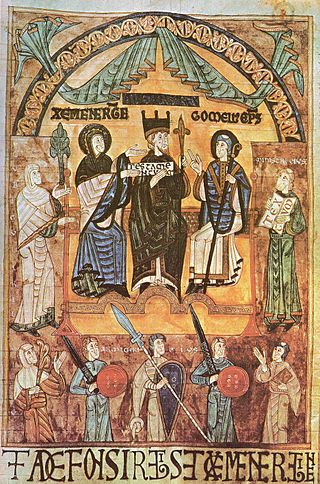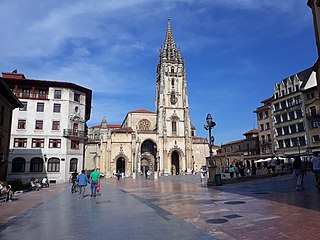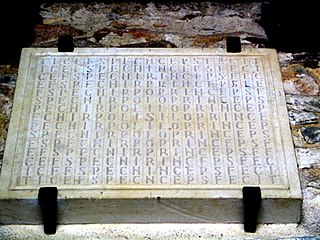The 780s decade ran from January 1, 780, to December 31, 789.

Year 783 (DCCLXXXIII) was a common year starting on Wednesday of the Julian calendar. The denomination 783 for this year has been used since the early medieval period, when the Anno Domini calendar era became the prevalent method in Europe for naming years.

The Kingdom of Asturias was a kingdom in the Iberian Peninsula founded by the Visigothic nobleman Pelagius. It was the first Christian political entity established after the Umayyad conquest of Visigothic Hispania in 711. In the Summer of 722, Pelagius defeated an Umayyad army at the Battle of Covadonga, in what is retroactively regarded as the beginning of the Reconquista.
Alfonso I of Asturias, called the Catholic, was the third king of Asturias, reigning from 739 to his death in 757. His reign saw an extension of the Christian domain of Asturias, reconquering Galicia and León.

Alfonso III, called the Great, was the king of León, Galicia and Asturias from 866 until his death. He was the son and successor of Ordoño I. In later sources, he is the earliest to be called "Emperor of Spain." He was also titled "Prince of all Galicia".

Oviedo or Uviéu is the capital city of the Principality of Asturias in northern Spain and the administrative and commercial centre of the region. It is also the name of the municipality that contains the city. Oviedo is located approximately 24 km (15 mi) southwest of Gijón and 23 km (14 mi) southeast of Avilés, both of which lie on the shoreline of the Bay of Biscay. Oviedo's proximity to the ocean of less than 30 kilometres (19 mi) in combination with its elevated position with areas of the city more than 300 metres above sea level causes the city to have a maritime climate, in spite of its not being located on the shoreline itself.

Silo was the king of Asturias from 774 to 783, succeeding Aurelius. He came to the throne upon his marriage to Adosinda, daughter of Alfonso I. He moved the capital of the Kingdom of Asturias from Cangas de Onís to Pravia, closer to the center of the kingdom. He was a contemporary of Abd al-Rahman I, Umayyad Emir of Córdoba, and of Charlemagne.

Mauregatus the Usurper was the king of Asturias from 783 to 788 or 789. He was an illegitimate son of Alfonso I, supposedly by a Moorish serf. He usurped the throne on the death of Silo, the husband of his half sister Adosinda, earning himself the nickname of the Usurper. The nobility had elected Alfonso II at Adosinda's insistence, but Mauregatus assembled a large army of supporters and forced Alfonso into exile in Álava.

Ramiro I was king of Asturias from 842 until his death in 850. Son of King Bermudo I, he became king following a succession struggle after his predecessor, Alfonso II, died without children. During his turbulent reign, he fended off attacks from both Vikings and the forces of al-Andalus. Architecturally, his recreational palace Santa María del Naranco and other buildings used the ramirense style that prefigured Romanesque architecture. He was a contemporary of Abd ar-Rahman II, Umayyad Emir of Córdoba.
This is a historical timeline of Portugal.
Adosinda was the queen of Asturias during the reign of her husband, Silo, from 774 to 783. She was a daughter of Alfonso I and Ermesinda, daughter of the first Asturian king, Pelayo. She was a sister of Fruela I.

Elvira García was Queen of León by marriage to King Bermudo II, and regent of Leon jointly with Count Menendo González during the minority of her son Alfonso V from 999 until 1008.

The Battle of Lutos occurred in 794 when the Emir of Cordoba, Hisham I sent military incursions against the Kingdom of Asturias under the command of the brothers Abd al-Karim ibn Abd al-Walid ibn Mugaith and Abd al-Malik ibn Abd al-Walid ibn Mugaith.

The Battle of Pancorbo took place in 816 between a Moorish army from the Emirate of Cordoba sent by Al-Hakam I and under the control of Abd al-Karim ibn Abd al-Wahid ibn Mugit and pro-Frankish forces under the control of Balask al-Yalasqi. The battle was fought when the Córdoban forces attempted to cross the pass at Pancorbo.

The Pantheon of Asturian Kings is a chapel of Nuestra Señora del Rey Casto in the Cathedral of San Salvador, Oviedo, Spain. It is the burial place of many of the rulers of the medieval kingdoms of Asturias and León.
The tribute of 100 virgins is a Spanish national myth as part of the Reconquista ideology. The legend rests on a narrative of annual tribute of one hundred virgin maidens paid by the Christian kingdom of Asturias to the Muslim emirate of Córdoba. The narrative also suggests that fifty were to be of noble birth and fifty commoners. The myth of tribute has been described "historically apocryphal but ideologically accurate" because it played important propaganda role in the formation and affirmation of the Reconquista ideology in the later Middle Ages, and it still figures prominently to this day in Spanish national cultural memory.

Fruela of Cantabria or Fruela Pérez was the second son of Duke Peter of Cantabria and brother of King Alfonso I of Asturias.

The Battle of Las Babias occurred in the year 795 when the Emir of Cordoba, Hisham I of Córdoba sought to avenge his previous military incursions in 794 against the Kingdom of Asturias under the command of the brothers Abd al-Karim ibn Abd al-Walid ibn Mugaith and Abd al-Malik ibn Abd al-Walid ibn Mugaith. The previous battles resulted in devastating losses for the Emirate, most importantly at the Battle of Lutos where one of the Emir's generals was killed in action. The battle resulted in a Córdoban victory.
The Primitive Way is one of the paths of the Camino de Santiago. It begins in the old Asturian capital of Oviedo and runs west to Lugo and then south to Santiago de Compostela joining the more popular French Way in Melide for the last two hiking days. According to the Confraternity of St James, the Camino Primitivo is approximately 320 km in length.















